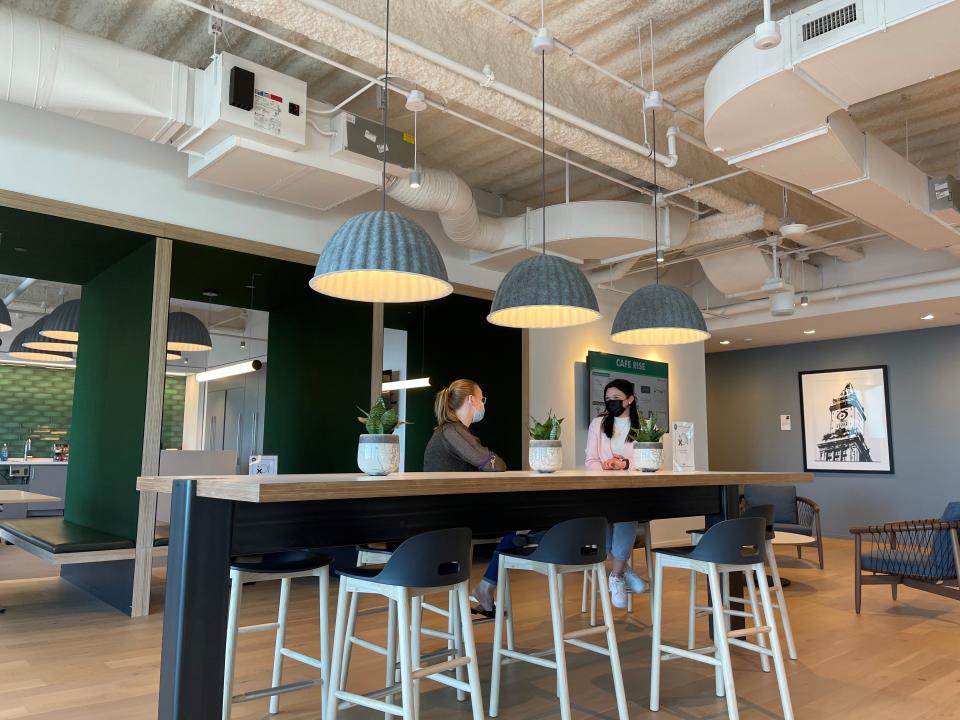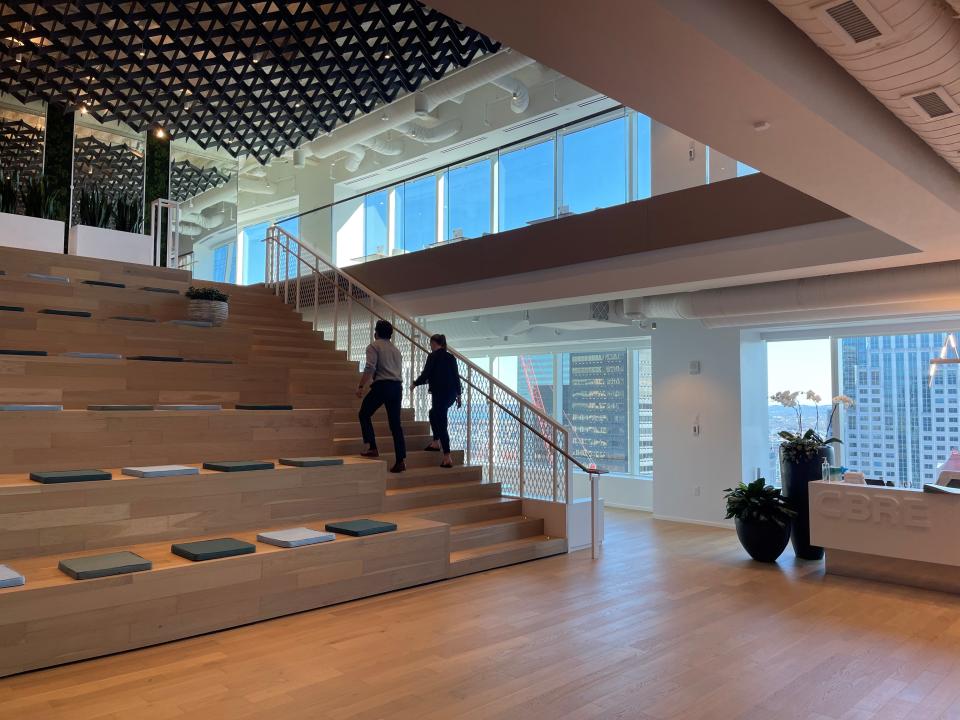Is the office back? COVID-19 created a work-from-home culture but companies are trying to make the office appealing again
Julie Whelan thought she understood how offices would change in a post-pandemic world.
As a lead researcher a CBRE, the world's largest commercial real estate services firm, she had spent a lot of time identifying trends that would shape how a reimagined workplace would look: More safety features, more communication devices and an atmosphere that encouraged productivity.
Still, when she stepped into her redesigned, super tech-enabled Boston office at her firm, Whelan felt disoriented.
Unlike her old office, the new space was bright with natural light and had no assigned desks. The workstations were empty except for hand sanitizers. The desks had no family pictures or piles of paper (think deep clean-friendly). A two-sided color-coded card on the desk would let her know if it had been cleaned after someone else had used it. Once she absorbed the changes, however, Whelan felt reassured by the design.
“I was able to go in and pick the desk that I felt comfortable sitting in,” she said.
The office also had a staircase with stadium-type seating, a living moss wall and Liquid Galaxy, which used a cluster of computers and multiple displays that could provide an immersive, panoramic view of real estate properties anywhere in the world.

Made in America: Biden administration unveils plan to raise corporate taxes
More than a year after offices across the country closed during the coronavirus lockdown, companies are preparing for employees to return as COVID-19 vaccinations pick up. In many cases, those workplaces could feel very unfamiliar, with reconfigured office layouts designed to encourage social distancing and sanitization even as workers collaborate.
The most popular amenities for landlords and tenants are safety features like app-enabled elevators, food dispensers and reservation systems for workstations. Then there are the microbe-zapping UV lights either built into the ceiling or emitted by roving robots.
In New York, many landlords in office buildings are stepping up their designs and technology to meet the changing demand of tenants, says Ryan Alexander, a CBRE executive vice president in New York City.
“There are thermal scanners in the lobby to take your temperature, hand scanners for touchless entry into buildings. If you're visiting a client or a company, they send you a guest barcode to your phone that you just scan,” he says.

Is the office back?
Even as companies prepare for a hybrid model of work, with employees working from home many days, experts say the office isn't going anywhere.
Seventy percent of office workers believe their workplaces are more conducive to collaborating with colleagues, solving complex issues, managing staff and connecting with leadership, according to a November 2020 report by JLL, a global commercial real estate services company headquartered in Chicago, which surveyed more than 2,000 global office workers.
At the same time, many companies are rethinking the role of the office, its design and the accompanying technology.
First, companies are looking to set up offices with hygiene as a priority.
“Clients are doing everything touchless, from bathroom faucets to elevator entries," says Albert De Plazaola, a principal at Unispace, a global workspace expert. "There are apps out there that will pretty much design your day,” he says. “We call them the digital concierge."
He's also seeing the use of materials like stainless steel and copper to reduce the spread of germs.
One of the big ideas to emerge now is the creation of flexible spaces that can be broken down and rearranged as needed. Furniture and retractable doors, for example, can create separate areas.
Even though most companies have made some investments, like in air purifiers and filtration systems, major changes to offices might not be immediate, says Steve Stratton, JLL’s chairman of Headquarters Practice Group.
That's because it's still unclear how much offices will be used after companies make big investments. And paying for these changes will be expensive.

Many companies are spending an average of about $40 per square foot to upgrade the technology in their space, says Christian Beaudoin, a managing director of research at JLL.
"We have several clients who are spending more than that, and others which are investing less," he said. "An aggregate number across the country is difficult to know for certain, but based on the rentable market across the U.S., it could total up to $160 billion over time."
Beaudoin says most companies have not invested significantly in capital projects to renovate their spaces. They are taking the approach of measuring their employee attendance over the next several months to get a more complete understanding of their workplace needs.
According to data from Kastle Systems – which operates security for thousands of buildings across the country – office occupancy is at 26% in 10 major cities across the country for the week of April 14, with Austin, Texas, leading the pack at almost 40%.
The concern of the real estate decision-makers and financial C-suite is not knowing what happens after 2022," Stratton says. "It's a new way of working, working from home, working in a hybrid model,” he says “It's a major capital investment."
Plugged in: How tech will help many of us readjusting back to the office post-COVID
While it is easier to make changes to projects that were already under construction before the pandemic began, retrofitting legacy offices can still be expensive.
That was true for Fredrikson & Byron, a law firm headquartered in Minneapolis. While the firm upgraded its offices in many states with plexiglass-divided workstations in multiple states, its Des Moines, Iowa, office was in the process of moving to a new space when the pandemic hit.
Bridget Penick, a lawyer who co-leads the firm’s Des Moines office, says the timing allowed her firm, which worked with Unispace, to include several solutions in response to the pandemic.
One was making sure all the offices for the attorneys had glass doors to draw in natural light, to boost a sense of well-being among employees. The firm also added retractable doors to a conference room to accommodate large gatherings for events and which could be closed off for privacy.
They also installed vegetation and plants between stations as a physical barrier as well as to get oxygen in the room circulating. The floors are polished concrete.
“Most law offices, if you think about them are kind of opulent and rich and a lot of material and carpeting,” Penick says. “But we wanted surfaces that were easily cleanable and durable. All the hallways and common areas have concrete floors. They can literally be bleached if we need to.”
Whelan, of CBRE, says the pandemic has accelerated trends that were already unfolding.
“A lot of organizations are now recognizing that these design changes need to happen to not only support a more modern worker but are also more efficient for the company," she says. "My own office feels much more spacious, much cleaner and much more energetic despite the lack of people."
Swapna Venugopal Ramaswamy is the Housing and Economy reporter for USA TODAY. Follow her at @SwapnaVenugopal on Twitter.
This article originally appeared on USA TODAY: Back to work: Will office redesigns, safety features lure employees?

